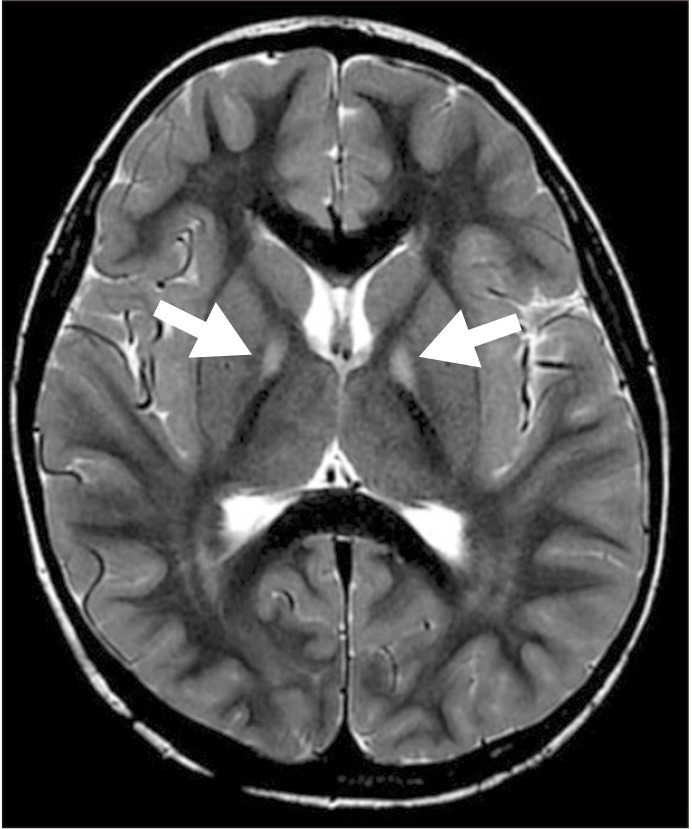Ann Rehabil Med.
2018 Apr;42(2):363-367. 10.5535/arm.2018.42.2.363.
Botulinum Toxin-A Injection in the Treatment of Spasticity in a Infantile-Onset Neurodegeneration With Brain Iron Accumulation: A Case Report
- Affiliations
-
- 1Department of Physical Medicine and Rehabilitation, Inje University Haeundae Paik Hospital, Inje University College of Medicine, Busan, Korea. cyctaz@hanmail.net
- KMID: 2432209
- DOI: http://doi.org/10.5535/arm.2018.42.2.363
Abstract
- Pantothenate kinase-associated neurodegeneration (PKAN) is a neurodegenerative disorder characterized by iron accumulation in the globus pallidus (GP) of the brain (neurodegeneration with brain iron accumulation [NBIA]), which is characterized by dystonia and spasticity resulting in postural difficulties. A 33-month-old boy was admitted with a pronounced gait disturbance. Marked hypertonicity in the patient's both calf muscles was noted, resulting in waddling with repeated slip-falls. NBIA was suspected by high T2 intensity in the GP on brain MRI, then it was confirmed by detecting PANK2 mutation. Botulinum toxin-A injection was administered to both calf muscles. After 2 weeks, a decrease in spasticity and an increase in range of motion were observed, and consequently, an increase in the patient's gait stability with both heels touching the ground, enabling him to walk straight independently. A definitive treatment for NBIA has not been established, and a symptomatic therapy is currently the mainstay of treatment in this case. This is the first case report of botulinum toxin injection for treatment of gait disturbance caused by spasticity in an infantile-onset PKAN.
Keyword
MeSH Terms
Figure
Reference
-
1. Gelman N, Gorell JM, Barker PB, Savage RM, Spickler EM, Windham JP, et al. MR imaging of human brain at 3.0 T: preliminary report on transverse relaxation rates and relation to estimated iron content. Radiology. 1999; 210:759–767. PMID: 10207479.
Article2. Kurian MA, McNeill A, Lin JP, Maher ER. Childhood disorders of neurodegeneration with brain iron accumulation (NBIA). Dev Med Child Neurol. 2011; 53:394–404. PMID: 21480873.
Article3. Gregory A, Polster BJ, Hayflick SJ. Clinical and genetic delineation of neurodegeneration with brain iron accumulation. J Med Genet. 2009; 46:73–80. PMID: 18981035.
Article4. Schneider SA, Hardy J, Bhatia KP. Syndromes of neurodegeneration with brain iron accumulation (NBIA): an update on clinical presentations, histological and genetic underpinnings, and treatment considerations. Mov Disord. 2012; 27:42–53. PMID: 22031173.
Article5. Gregory A, Hayflick SJ. Pantothenate kinase-associated neurodegeneration. In : Adam MP, Ardinger HH, Pagon RA, Wallace SE, editors. GeneReviews. Seattle: University of Washington;1993.6. Graham HK, Aoki KR, Autti-Ramo I, Boyd RN, Delgado MR, Gaebler-Spira DJ, et al. Recommendations for the use of botulinum toxin type A in the management of cerebral palsy. Gait Posture. 2000; 11:67–79. PMID: 10664488.
Article7. Egan RA, Weleber RG, Hogarth P, Gregory A, Coryell J, Westaway SK, et al. Neuro-ophthalmologic and electroretinographic findings in pantothenate kinase-associated neurodegeneration (formerly Hallervorden-Spatz syndrome). Am J Ophthalmol. 2005; 140:267–274. PMID: 16023068.
Article8. Seo JH, Song SK, Lee PH. A novel PANK2 mutation in a patient with atypical pantothenate-kinase-associated neurodegeneration presenting with adult-onset Parkinsonism. J Clin Neurol. 2009; 5:192–194. PMID: 20076801.
Article9. Crisci C, Esposito M. Efficacy of botulinum toxin A treatment in a case of pantothenate kinase associated neurodegeneration (PKAN). BMJ Case Rep. 2011; 5. 16. [Epub]. DOI: 10.1136/bcr.07.2011.4514.
Article
- Full Text Links
- Actions
-
Cited
- CITED
-
- Close
- Share
- Similar articles
-
- Treatment of Pantothenate-Kinase Neurodegeneration With Baclofen, Botulinum Toxin, and Deferiprone: A Case Report
- Improvement of Lingual Dystonia Following Cerebellar Infarction through Botulinum Toxin Injection: a Case Report
- Practical Points of Botulinum Toxin Injections for Spasticity of Upper Extremity
- Ultrasound-Guided Botulinum Toxin Injection with Factor VIII Administration for Post Stroke Spasticity in a Hemophilia A Patient
- Effects of Botulinum Toxin A Treatment in Cerebral Palsy


